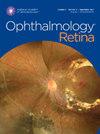Prevalence, Features, and Outcomes of Type 1 Neovascularization in Eyes with Angioid Streaks
IF 4.4
Q1 OPHTHALMOLOGY
引用次数: 0
Abstract
Purpose
This study aimed to delineate the characteristics, prevalence, and outcomes of neovascularization (NV), particularly aneurysmal type 1 NV, in patients with angioid streaks (AS) secondary to pseudoxanthoma elasticum (PXE), and to introduce a clinical classification based on multimodal imaging.
Design
Retrospective longitudinal cohort study.
Participants
Eighty-five patients (168 eyes) with AS secondary to PXE at 2 tertiary referral centers.
Methods
Data collection included demographic, medical, and ocular histories. Diagnostic methods comprised fundus photography, autofluorescence, indocyanine green angiography, OCT, and OCT angiography.
Main Outcome Measures
Prevalence of type 1 NV, visual acuity (VA), risk of exudation.
Results
Type 1 NV was identified in 127 eyes (76%), with 85 of these (67%) showing exclusively type 1 NV. These lesions often originated around the disc, at sites of Bruch membrane dehiscences, and followed the path of AS, extending to the macula in 101 eyes (80%). Despite 65% of type 1 NV remaining nonexudative, 35% evolved into exudative over 5 years, and 11 eyes experienced midperipheral subretinal hemorrhages. Aneurysmal dilations, observed in 57% of eyes, substantially increased exudation risk (hazard ratio = 3.86, P = 0.02). Despite treatment, VA significantly deteriorated in exudative type 1 NV (P = 0.02). Type 2 NV, detected in 42 eyes (33%), often coexisted with type 1 NV and was associated with poorer visual outcomes and higher rates of macular atrophy. A classification of AS was developed, ranging from empty AS (stage 0, no NV) to advanced NV (stage 3, both type 1 and type 2 NV).
Conclusions
Type 1 NV predominates in AS. Although predominantly nonexudative, its progression correlates with substantial visual impairment, similar to the deficits observed with type 2 NV. Aneurysmal type 1 NV poses a significant exudation risk, underscoring the need for vigilant monitoring.
Financial Disclosure(s)
Proprietary or commercial disclosure may be found in the Footnotes and Disclosures at the end of this article.
有血管条纹的眼睛中 1 型新生血管的发病率、特征和预后。
目的:本研究旨在明确假黄瘤(PXE)继发血管样条纹(AS)患者的新生血管(NV),尤其是动脉瘤样1型NV的特征、患病率和预后,并引入基于多模态成像(MMI)的临床分类:设计:回顾性纵向队列研究。参与者:两家三级转诊中心的85名PXE继发性血管样条纹(AS)患者(168只眼):数据收集包括人口统计学、医学和眼科病史。诊断方法包括眼底照相、自动荧光、吲哚菁绿血管造影、光学相干断层扫描(OCT)和 OCT 血管造影:主要结果指标:1 型 NV 的患病率、视力(VA)、渗出风险:结果:127 只眼睛(76%)发现了 1 型 NV,其中 85 只(67%)完全是 1 型 NV。这些病变通常起源于椎间盘周围的布鲁氏膜裂孔部位,并沿着AS的路径发展,101只眼睛(80%)的病变延伸至后极。尽管 65% 的 1 型 NV 仍为非渗出性,但 36% 的 1 型 NV 在五年内演变为渗出性,11 只眼睛出现中周视网膜下出血。在57%的病例中观察到动脉瘤扩张,这大大增加了渗出风险(危险比=3.86,P=0.02)。尽管进行了治疗,但渗出性 1 型 NV 的视力仍明显下降(p=0.02)。56只眼睛(33%)发现了2型NV,2型NV通常与1型NV并存,与较差的视觉效果和较高的黄斑萎缩率相关。对强直性脊柱炎进行了分类,从空白强直性脊柱炎(0期,无NV)到晚期NV(3期,同时存在1型和2型NV):结论:1型NV在AS中占主导地位。结论:1型NV在强直性脊柱炎中占主导地位,虽然主要是非渗出性的,但其进展与严重的视力损害相关,与2型NV观察到的缺陷相似。动脉瘤 1 型 NV 有很大的渗出风险,因此需要警惕监测。
本文章由计算机程序翻译,如有差异,请以英文原文为准。
求助全文
约1分钟内获得全文
求助全文

 求助内容:
求助内容: 应助结果提醒方式:
应助结果提醒方式:


